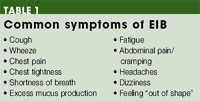A guide for pediatric providers on exercise-induced bronchospasm (CME)
An overview of the epidemiology, etiology, symptoms, common diagnostic tests, and various treatments of exercise-induced bronchospasm in the pediatric population.
Exercise-induced asthma (EIA) and exercise-induced bronchospasm or bronchoconstriction (EIB) are all terms that have been used to describe airway narrowing that occurs in response to exercise. Some authorities will use EIA to describe this phenomenon only in asthmatic patients, reserving EIB for those without such a diagnosis. For the purposes of this discussion, EIA can be thought of as asthma triggered by exercise. Given that most pediatric practitioners have a good deal of experience managing asthma (and EIA), this article will focus on the less familiar EIB.
Epidemiology
EIA has been reported to have a prevalence of up to 90%, signifying that 90% of asthmatic patients will have symptoms with exercise.1 Rates of EIB, on the other hand, vary greatly depending on the population sampled and the diagnostic method employed. It appears to be most widespread in elite and cold-weather athletes, with rates as high as 50% in elite summer athletes2 and Olympic cross-country skiers.3 In the pediatric population, 9% to 12% of adolescent athletes4,5 and high school football players6 were shown to have EIB. Most recently, Parsons et al reported a prevalence of 39% in varsity college athletes.7 This study found no gender differences; however, a female predominance has been shown in US Winter Olympic athletes.1,8
There are two main theories to explain the cause of EIB. In the thermal or "heat loss" hypothesis, cool air inhaled during exercise causes pulmonary vasoconstriction, followed by a reactive hyperemia after exercise to re-warm the airways. The hyperemia and resulting bronchial congestion and edema cause airway narrowing. Additionally, the initial airway cooling stimulates cholinergic receptors to increase secretions and airway tone.9,10 This theory helps explain the high prevalence of EIB during winter sports, but not why people experience EIB during warmer weather.
An alternate explanation is the osmotic or "water loss" hypothesis, which holds that the inspiration of large volumes of dry air during exercise initiates a cascade of events beginning with evaporative water loss. Evaporation leads to increased osmolarity of the extracellular fluid, which in turn causes activation of epithelial cells and mast cells in the bronchial mucosa, and the subsequent release of inflammatory mediators such as histamines, leukotrienes, and prostaglandins. These mediators cause the bronchial smooth muscle contraction and airway edema that lead to EIB symptoms.9,11,12
Airborne irritants and allergens may also play a role. Chlorine used to disinfect swimming pools reacts to form chloramines in the air above the water, and is a potential cause of airway inflammation when inhaled. These compounds have been correlated with asthma symptoms and bronchoconstriction in pool workers and schoolchildren.13,14 Metal particulate matter and nitrogen oxides given off by ice-resurfacing equipment may explain the higher-than-expected levels of EIB seen in hockey players and figure skaters.15 In atopic patients, the hyperventilation associated with strenuous exercise exposes the airway to environmental allergens such as pollen, which trigger inflammatory mediators.11
Making the diagnosis
